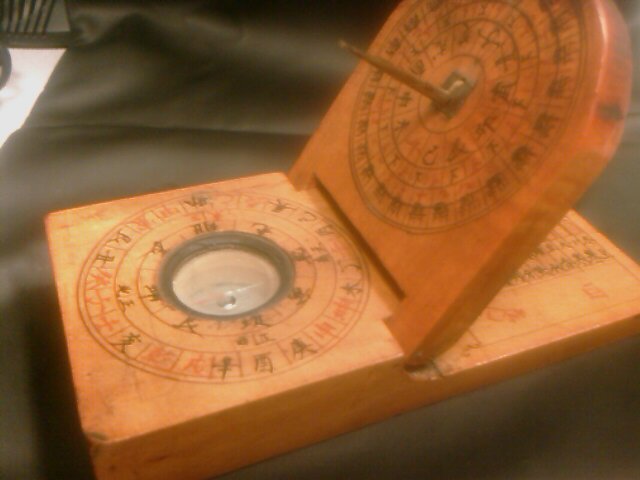Telling the time (and more) |
In my continuing interest in gadgets, here is one that doesn't care about 3G, RAM size or processor speed, though indirectly does care about GPS. My interest in portable sundials was sparked some years ago when I found a portable sundial for sale in an open market in Beijing, China.

The above portable compass should be directed to point south, and the hinged dial face should be set at an angle. Behind the face is a small brass lever that should be aligned with the stepped stages marked with periods of the year (from summer solstice to winter solstice with the equinoxes in the middle).

The ring dial actually has its own web-site, unfortunately there isn't a url on the device itself, which would be an interesting clash in technology. Go to http://www.sunwatchmaker.com/ for more details of the device itself.

Of course you may consider a simple brass antique looking chronometer boring and want to know what would happen if modern designers got to redesign it. Well it looks like they have. Helios Icarus Pocket Sundial is the iPhone of pocket universal equinoctial sundials (iCarus ?).

The Icarus offers an explicit world map, making it easier to set for latitude and time zone correction. It also has an explicit equation of time adjustment to help accuracy. Something my own universal ring does not have. The Icarus is also expensive, even though it does come unlocked, and may be used worldwide without roaming charges (the web site doesn't mention what the cost would be with a 2 year plan with AT&T).
First position the outer ring hanging point for your latitude. This means when you hang the ring dial by its cord the inner time ring will be parallel to the equator (this latitude correction is not available for the Chinese compass sundial above). The second thing is to position the hasp on the central column to the time of year. This is adjusting for the season which is directly analogous to the lever angling the sundial face on the Chinese compass. Now you hold the ring dial by its cord and keeping the top of the middle column towards north you turn it round until the sun goes through the small hole in the center. Where the sun hits to the time ring is the current local time.
Of course this is the solar time, not the standard time, so you have to know what the different between local time and standard time, which will be further out during the summer if your time zone supports daylight saving time.
Once you play with it, it is cool, and its nice to see it actually work. Of course its not very accurate, but you can get accuracy to about 15 minutes or so.
But now what?
Once you think about what this ring dial can do, you realise it can actually be used for more than just telling the local time.
First set the outer ring to the latitude of the place you are interested in. Position the hasp on the middle column to the season you want, and open the time ring. Hold the ring dial up to the level off your eye, so you can see the horizon through the hole. Position the middle column to point northward. Then slowly turn the device clockwise until the time ring obscures the hole. Read off the time that point on the ring. That is the (local) time of the sunset. Turn the device (counter/anti)-clockwise until the other side of the time ring obscures the hole. That is the local time of sunrise.
This certainly makes the ring dial much more useful that just a device for telling the time. The device can be used without any sun, and for any place (or season) that you want to know about the sun rise ant set times.
How many hours until sunset?. Another use of the ring dial is using it to tell how much more sunlight there is in the day. This can time by telling the local time, then twisting the device clockwise until the time ring obscures the hole, then counting the time difference between them. Note in this case you don't even need to know what the local time to standard time offset is.
How many hours until sunrise?, in the middle of the night you might want to know how many hours it is until the sun rises. This wont work with this device (as the sun is below the horizon). You can tell when sunrise is, but you'll need an alternate method to get local time during the night. Such a device does exists, but its a separate device. Its called a nocturnal and depends on the position of (typically) Cassiopeia around the pole star (currently not available in the Southern Hemisphere).
I actually have a nocturnal too. I bought my nocturnal from Compass Rose Geocoin which includes an explanation of how to use it. Basically it is using the position of Cassiopeia (but not that one) with respect to the Great Bear to tell the time. Although this chronometer does have a url on it, clicking on it has no effect (maybe I don't have the right plugin installed on the device).
